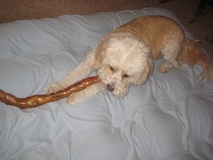 Your dog is tensed on his bed, a bone pressed between his front paws. As you move closer, he stiffens, and you hear a low growl. You reach for the bone, and he snaps. This is a clear-cut example of resource guarding. This is a totally natural behavior in the animal world – a stray dog, for example, may have to guard the scraps of food they find to be able to eat. In theory, pet dogs should have moved past the need to guard the things they see as resources – after all, they have everything they need in our homes, right? But in reality, many dogs still display this behavior, sometimes in a way that can be dangerous for the people and animals interacting with them. Dogs view a lot of things as resources – food, toys, their dog bed, sometimes even their people. Food and chews like bones are the most common source of resource guarding, so I will use that as an example throughout this post, but many things can be subject to guarding by your dog. So what do you do when your dog is resource guarding? Step one is prevent the situation from escalating. If your dog has a bone, and starts to guard it, do NOT take try to take the bone. Many dog owners think that allowing the dog to keep the bone is reinforcing their bad behavior, but actually, your dog generally is guarding because they feel insecure about the resource, so taking it away will just make the behavior more intense in the future as you will now be viewed as even more of a threat to their resources. Trying to take the bone also significantly increases your chances of a bite happening. There are no “winners” when dealing with aggressive behavior – safety is far more important than showing your dog who’s boss. Remember: your dog is not guarding their bone because they are being dominant or to defy you. Most of the time, they are reacting instinctively to the worry that you going to take their resource away, and are trying to prevent that from happening. There are a few resource guarding protocols online or in publication (“Mine!” by Jean Donaldson is a great reading option for people with resource guarders). The basic idea of many of them is the same: you want to create a good association with you approaching when your dog has the resource they are trying to protect. You will need to set up a safe scenario here first. So let’s say your dog guards his food bowl at breakfast. When he has his breakfast, approach only to the point where he knows you are there, but is not yet reacting – you want to stay at a safe distance and keep your dog under threshold. Once you get to the right spot, toss a super-tasty treat (I like to use something really high-value like hot dog or chicken) into his bowl or as close as you can get and walk away. Repeat this step until your dog is totally comfortable with you approaching at that distance. If he seems happy and relaxed with your approach, start gradually moving closer and closer. In most cases, you should eventually be able to touch or move the bowl without the dog reacting negatively. This works because every step of the process heavily pairs your approach with really good stuff, so you getting closer becomes something awesome instead of something scary. This is a very simplified version of dealing with a complicated issue. If you have a dog who guards his resources in a way that is dangerous (lunging, snapping, etc.), enlist the help of a behavior professional to make sure your training plan is set up in the correct way. The goal is to always keep the process safe and effective, so that your dog goes from growling when you approach their bone to wagging their tail in excitement.
3 Comments
12/24/2022 12:28:18 pm
Sleep in if you can, take longer to get ready in the mornings and relax often.
Reply
Leave a Reply. |
Sarah Bond
Sarah is a Certified Dog Behavior Consultant and Certified Professional Dog Trainer - Knowledge and Skills Assessed. She lives in the Texas Hill Country near Austin with her two dogs, Percy, a cattle dog mix, and Clara, a lab/German Shepherd. Archives
October 2020
Categories |
 RSS Feed
RSS Feed